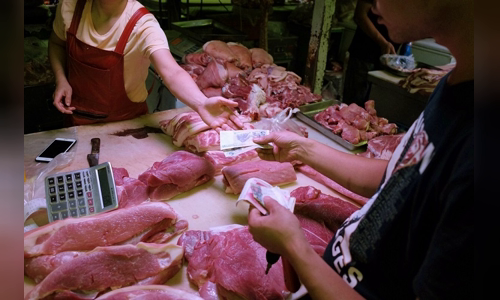China As an office cleaning worker, Gan Xiaoge witnessed China's dizzying economic growth and the opportunities it offers.
Gan Xiaoge took a car nearly 200 km from Anhui province, eastern China to Beijing to look for work a few years ago, when the country's economy was growing rapidly, bringing many job opportunities with decent income for poor people like her.

The soaring price of pork has led to an increase in the price of other commodities, which has plagued Chinese workers Photo: SCMP.
However, as China's economic growth has recently slowed down and prices of staple goods such as pork have skyrocketed as a result of the African swine cholera epidemic, Gan, as well as hundreds of thousands of other Chinese workers, begin. "wake up".
"The price of pork has gone up too much in recent months and I am about to be unable to buy meat anymore. The landlord has increased the rent from 500 yuan (71 dollars) to 800 yuan (114 dollars) and then increased to 1,000 yuan ("). 142 USD) in just three months, "Gan said.
China's GDP increased by 6% in the third quarter, triple its GDP growth (1.9%) and was an incredible economic growth for such a large country. However, this is the lowest increase of China since 1992.
Stagnant economic growth is having a strong impact on the lives of migrant workers like Gan and low-income groups.
"We are not protected from soaring rent and landlords can always easily find new tenants. The salary in Beijing is just barely enough to survive the day," Gan said.
Peers like Gan are feeling the effects of the economic slowdown in many different ways, including the job market. According to the Ministry of Manpower and Social Security, China's urban unemployment rate for the third quarter stood at 3.61%. This index remained at nearly 4% for many years, and equivalent to the US unemployment rate.
However, more and more Chinese manufacturing companies decided to fire their employees as foreign orders dropped sharply due to the trade war with the US.
China's employment index fell below 47% in August, the lowest level since the 2007-2008 global economic crisis. This index increased slightly to 47.3% in October, but the employment rate of less than 50% showed that many factories are reducing labor.
In fact, China's economy has slowed down before the start of the U.S.-China trade war in 2018. One of the reasons for this slowdown is Beijing's attempt to reduce public debt and discontent. social status, which has worsened as the Chinese government pursues an export-focused strategy to build the world's leading industry with cheap labor.
At present, Chinese President Xi Jinping is seeking to cope with the "side effects" of the strategy by reducing China's dependence on exports and turning domestic consumption into a growth engine. Some experts say Xi's new strategy has yet to show "sweet fruit."
"Beijing is struggling to rebalance economic growth towards consumer spending, which suggests that any growth stimulus effort will focus on investment," said Diana Choyleva, head of the expert group. economics at the economic and political prediction firm Enodo Economics, said.
"It seems that Xi is ready to accept lower economic growth. He is more interested in reducing inequality and addressing the threat from that problem than economic growth and markets. finance, "added Choyleva.
However, declining economic growth is only one of the reasons stifling workers' income.
An outbreak of African swine cholera, forcing authorities to destroy millions of pigs and cause a drop in pork supply, has led to skyrocketing commodity prices.

A worker cleans a building glass in Beijing, China Photo: Reuters
According to the National Bureau of Statistics of China, consumer prices in September increased by 3% over the same period last year, the largest increase in nearly 6 years, mainly due to the increase in pork prices.
Chinese people have a tradition of saving, with savings rates far above those in most other countries. However, according to the Organization for Economic Co-operation and Development (OECD), since China's economic growth peaked in 2010, household savings as a percentage of income have steadily decreased. The saving index decreases as the government encourages domestic consumption to reduce China's dependence on exports.
Meanwhile, household debt increased significantly during the same period. The International Monetary Fund (IMF) estimates China's total household debt at 50.3% of GDP in June 2018, higher than the average of emerging markets and up 32% from 10 years ago. .
The IMF said the increase in the index raised concerns that continued debt growth could lead to adverse effects on economic growth and financial stability.
Not only are households accumulating debt, the Chinese central and local governments are in the same situation.
Nick Marro, world trade expert at the Economic Intelligence Agency (EIU), said he was not surprised by the slowdown in the Chinese economy. However, he estimates that real growth figures may be even lower without the impact of tax cuts.
The Chinese government has reduced taxes to boost spending and stimulate growth, but this has also had a "side effect" of reducing the revenues of local governments, forcing them to increase borrowing. .
"Increasing reliance on unsustainable debt to achieve economic growth targets will be a threat to the world economy," Marro said. "However, drastic growth policies will increase the current public debt burden, which will affect the health of China's economy in the medium and long term," Marro said.
In addition, the slowdown of economic growth is uneven across the country, which is causing headache for policy makers.
According to official data, in the first 6 months, the economy of 14/25 provinces in China increased higher than the national average. The difference in growth rate is also significant, with Yunnan province having the highest growth rate of 9.2%, while Tianjin province near Beijing ranked last with 4.6%.
The fact that the growth rates of localities are so wide disparities makes the Chinese government unable to apply "one-size-fits-all" solutions, while the decline of the national economy shows that the regions are few. Resources are suffering more pain.
"Usually coastal provinces are more prepared for economic fluctuations, because they have more economic resources, from businesses, governments, human resources and labor," said Tommy Wu, an expert Senior economist at Oxford Economics, shared with Al Jazeera. "The northeastern and central provinces of China have lower productivity and are likely to have high levels of public debt," Wu said.
While the Chinese government has few options to minimize the impact of the economic slowdown, the way for poor workers like Gan to overcome the difficult situation seems clearer. "I will take on part-time jobs and cut down on unnecessary expenses," Gan said.



 IshazFwie
IshazFwie







